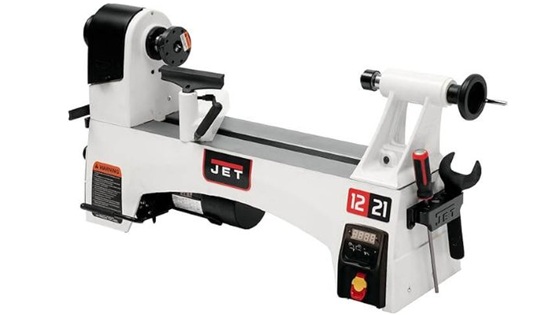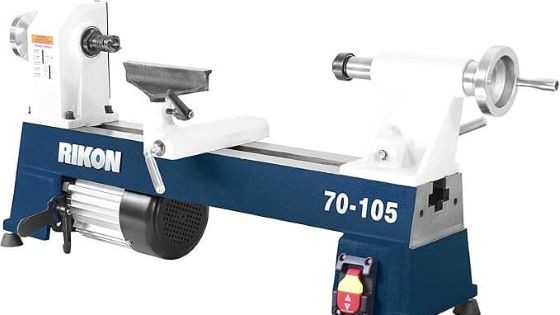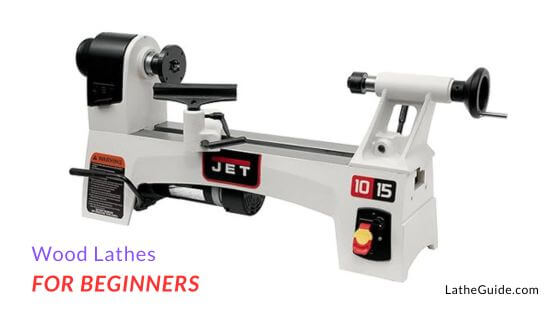
Stepping into the world of woodturning is an exciting prospect! The idea of transforming a simple block of wood into a beautiful bowl, an elegant pen, or a functional tool handle using a spinning lathe is captivating. However, choosing your very first wood lathe can feel overwhelming. With so many sizes, features, and price points, where does a beginner even start? Getting the best wood lathe for beginners is crucial for a positive, safe, and encouraging learning experience.
This guide is specifically designed to help newcomers navigate the options. We’ll break down the key features that matter most when you’re starting out, discuss different types of beginner-friendly lathes, and review some top picks for 2025 that offer a great balance of usability, capability, safety, and value. Let’s get you turning!
Key Things to Consider When Choosing a Best Wood Lathe for Beginners
While advanced features are tempting, beginners should prioritize these aspects:
Size and Capacity (Mini or Midi is Often Ideal)
- Mini Lathes (approx. 8-10″ swing, 12-18″ between centers): Excellent starting point. They are less intimidating, more affordable, take up less space, and are perfectly suited for learning fundamentals on smaller projects like pens, boxes, handles, and small spindles.
- Midi Lathes (approx. 12″ swing, 16-21″ between centers): A great “step-up” beginner option if budget and space allow. They offer more stability, power, and capacity (for small to medium bowls) providing more room to grow without being overly large.
- Key takeaway: Start with a size appropriate for the small-to-medium projects you’ll likely tackle while learning.
Ease of Use
Look for lathes with straightforward controls, clear instructions, and relatively simple setup. Overly complex machines can add frustration to the learning process.
Speed Control (Variable Speed vs. Manual Belt Change)
- Manual Belt Change: Requires stopping the lathe and moving a belt between different sized pulleys to change speed. Found on many budget-friendly beginner lathes. It’s reliable and teaches speed discipline, but less convenient.
- Electronic Variable Speed (EVS / VSR): Allows speed changes via a knob or dial while the lathe is running, often with a digital readout (DRO). Much more convenient and considered safer by many as you can easily adjust speed for different operations or wood types. EVS typically costs more.
- Recommendation: If your budget allows, EVS is highly recommended for beginners due to its ease of use and safety advantages. However, a manual-change lathe is perfectly adequate for learning if budget is tight.
Build Quality and Stability (Cast Iron is Key!)
Avoid lathes with excessive plastic, especially in the bed, headstock, or tailstock. Cast iron construction is crucial, even for beginner models. It provides weight and rigidity, which minimizes vibration. Less vibration means safer operation, smoother cuts, and an easier time learning tool control.
MT2 Tapers (Highly Recommended)
Look for lathes with MT2 (Morse Taper #2) in both the headstock and tailstock. This is the standard size on larger lathes and provides access to a vast range of affordable, quality accessories (drive centers, live centers, drill chucks). Avoid MT1 tapers if possible, as accessory options are more limited.
Adequate Motor Power
Beginners don’t need immense power, but an underpowered motor is frustrating. For mini lathes, 1/3 HP to 1/2 HP is often sufficient. For midi lathes, 3/4 HP to 1 HP is common and provides more capability.
Safety Features & Considerations
While lathes don’t have many built-in “safety features” like table saws, look for easily accessible ON/OFF switches. The most critical safety comes from your practices: always wear a face shield, use sharp tools correctly, understand speed settings, and secure the workpiece properly.
Budget
Establish a realistic budget, remembering to factor in the cost of essential tools, sharpening supplies (for HSS), and safety gear – these are not optional!
Top Picks: Best Wood Lathes for Beginners in 2025
Here are a few lathes consistently recommended for those starting their woodturning journey:
Disclaimer: This selection is based on general market reputation, features suitable for beginners, and overall value as of 2025. Availability and pricing may vary. Always do final checks before purchasing.
1. RIKON 70-105 Mini Lathe – Best Overall Beginner Value (Manual Speed)

- Why it’s great for Beginners: Strikes an outstanding balance between affordability and quality. Its solid cast iron construction provides excellent stability, minimizing vibration which is key for learning. The crucial MT2 tapers offer wide accessory compatibility for future growth. Simple, reliable manual speed changes teach speed discipline.
- Key Specs: 10″ Swing, 18″ Distance, 1/2 HP Motor, 5-Speed Manual (500-3200 RPM), MT2 Tapers.
- Pros: Excellent value, robust cast iron build, MT2 tapers, reliable, good stability for its size.
- Cons: Manual speed changes are less convenient than EVS.
2. WEN 3421 Variable Speed Mini Lathe – Best Budget Variable Speed Option

- Why it’s Great for Beginners: Offers the convenience of Electronic Variable Speed at an extremely attractive entry-level price point. If you really want VS but have a tight budget, WEN is hard to beat. It allows easy speed adjustments while learning different techniques.
- Key Specs (Varies by model): Typically 8-12″ Swing, 12-18″ Distance, ~1/3 to 1/2 HP Motor, Variable Speed (often ~750-3200 RPM).
- Pros: Very affordable Variable Speed, easy speed adjustments, compact size.
- Cons: Build quality may use less cast iron than Rikon, potentially less stable, MT1, lower motor power on some models.
3. Grizzly T25920 12″ x 18″ VSR Lathe – Best “Step-Up” Beginner Midi

- Why it’s Great for Beginners: For those with a slightly larger budget and space, this midi lathe offers more capacity and power, plus the desirable EVS and a Digital Readout (DRO). It provides significant room to grow into larger projects like medium bowls while still being manageable. It represents great value for an EVS midi lathe.
- Key Specs: 12″ Swing, 18″ Distance, 3/4 HP (typically), EVS (~650-3800 RPM) with DRO, MT2 Tapers.
- Pros: EVS and DRO included at a good price, more power and capacity than mini lathes, solid cast iron parts, MT2 tapers.
- Cons: Higher price than mini lathes, belt change still needed for full speed range, potential fit/finish not as premium as top brands.
4. JET JWL-1015VS 10″ x 15″ Variable Speed Wood Lathe – Premium Beginner Option (Variable Speed)
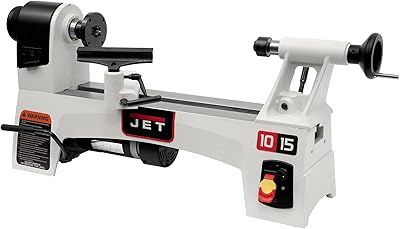
- Why it’s Great for Beginners: For beginners with a slightly higher budget who prioritize top-notch build quality and the convenience of Electronic Variable Speed right from the start, the JET JWL-1015VS is a fantastic, albeit smaller, option. It offers the renowned JET quality, smooth operation, wider speed ranges accessible via EVS, and MT2 tapers in a compact package perfect for learning precision work.
- Key Specs: 10″ Swing, 15″ Distance, 1/2 HP Motor, Variable Speed (e.g., 200-3600 RPM across 3 ranges), Digital Readout likely, MT2 Tapers.
- Pros: Excellent JET build quality and finish, smooth EVS with wide speed range, MT2 tapers, compact but stable, great for detailed work and small projects.
- Cons: Significantly more expensive than other mini lathes, smaller capacity (15″ between centers) compared to Rikon/Excelsior.
5. Shop Fox W1704 1/3 HP Benchtop Lathe – The Ultra-Budget Starter Option
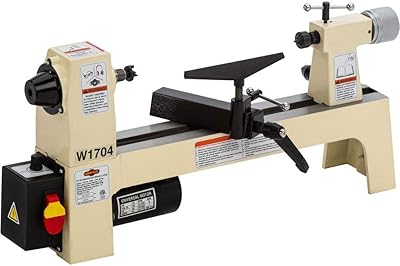
- Why it’s Great for Beginners (with Caveats): If your absolute primary concern is the lowest possible entry cost into woodturning, the Shop Fox W1704 is an incredibly popular starting point. It’s a very basic, no-frills machine that allows you to try out fundamental spindle turning techniques without a significant financial commitment. It’s simple to operate and widely available.
- Key Specifications (Verify specifics at time of purchase):
- Swing Over Bed: 8″ (Sometimes listed slightly larger)
- Distance Between Centers: 12″ or 13″
- Speed Control: Manual Belt Change (Often 5 Speed Steps, e.g., ~700-3200 RPM)
- Motor: 1/3 HP
- Taper: MT1 (Morse Taper #1)
- Spindle Thread: Often 3/4″ x 16 TPI
- Construction: Cast Iron Bed (typically)
- Weight: Approx. 45-50 lbs
- Pros:
- Extremely Affordable: One of the lowest-priced lathes available.
- Very Simple Operation: Easy to understand for absolute beginners.
- Compact and Lightweight: Fits in the smallest workshops.
- Widely Available: Often found at various tool retailers online.
- Cons:
- MT1 Tapers: Significantly limits the choice of compatible, quality accessories (chucks, centers) compared to MT2. This is a major drawback for future expansion.
- Low Motor Power (1/3 HP): Struggles with anything beyond very small, soft wood projects.
- Lighter Construction: Prone to more vibration compared to heavier models like the Rikon 70-105.
- Manual Speed Changes: Standard for budget machines.
- Best Suited For:
- Absolute beginners on the tightest budget wanting to simply try woodturning.
- Making very small items like miniature figures, small knobs, or basic pens (though pen making often benefits from MT2).
- Users who understand the significant limitations (especially MT1 taper) and prioritize cost above all else.
Getting Started: Beyond the Lathe
Remember, the lathe is just one part of the equation. As a beginner, you’ll also need:
- Basic Turning Tool Set: Choose either HSS (requires sharpening setup) or Carbide (easier start, replacement cutters). A small starter set is sufficient initially.
- Sharpening System: If using HSS tools, a grinder (preferably slow speed) and sharpening jigs are essential.
- Safety Gear: NON-NEGOTIABLE! A Full Face Shield and Dust Mask/Respirator are the absolute minimum.
- Work Holding Basics: Your lathe will come with a drive center and live center for spindle turning. A scroll chuck is highly recommended for bowls and other projects later on.
- Learning Resources: Look for local woodturning clubs, online forums (like AAW – American Association of Woodturners), YouTube tutorials, and beginner books.
Making Your Choice: Final Thoughts for Beginners
Choosing your first lathe comes down to balancing your budget, your available workshop space, the types of projects you envision starting with, and your preference for Variable Speed vs. Manual Speed Change.
Don’t feel pressured to buy the biggest or most feature-rich lathe immediately. Starting with a solid, reliable mini or midi lathe like the ones recommended above allows you to learn the fundamental skills safely and enjoyably. Focus on mastering tool control and sharpening (if using HSS) before worrying too much about maximum capacity or power.
Once you’ve selected your machine, remember that the right tools and accessories are just as important. For a deeper dive into those essentials, check out our Essential Wood Lathe Tools and Accessories Guide. And if your ambitions already extend beyond beginner models, our review of the overall Best Wood Lathes explores more advanced options.
Conclusion: Start Your Turning Adventure!
Embarking on woodturning is an incredibly rewarding experience. Selecting the best wood lathe for beginners sets you up for success by providing a stable, safe, and capable platform to learn and grow. Whether you choose the exceptional value of the RIKON 70-105, the budget-friendly variable speed of a WEN, or step up to a versatile midi like the Grizzly T25920, the key is to get a machine that fits your needs and encourages you to spend time practicing. Prioritize safety, be patient with the learning curve, and most importantly, have fun creating!


